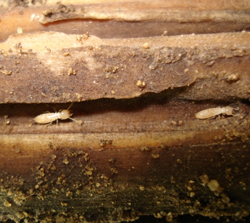 The University of Florida is continuing its research into the use of termite enzymes to help make cellulosic ethanol commercially viable.
The University of Florida is continuing its research into the use of termite enzymes to help make cellulosic ethanol commercially viable.
As we reported last year, researchers at UF have been working on genetic sequencing to harness the insects’ ability to churn wood into fuel. Now they report that they have isolated two enzymes that termites use to break up lignin, which is the tough nut to crack when it comes to producing ethanol from cellulosic material such as woody biomass. The material is normally exposed to heat and steam or caustic acids and bases to break down the lignin barrier around the sugar molecules, which adds to the cost of the process. However, the enzymes found in termite salivary tissues may be able to accomplish the same task, and at room temperature.
 “Once we figure out the best way to integrate this sort of enzyme into the process, it could drop the cost of producing cellulosic ethanol significantly,” said UF entomologist Mike Scharf, who led the research.
“Once we figure out the best way to integrate this sort of enzyme into the process, it could drop the cost of producing cellulosic ethanol significantly,” said UF entomologist Mike Scharf, who led the research.
The research was a collaboration between UF/IFAS and the biotechnology company Chesapeake-PERL Inc. of Savage, Maryland. The work was funded by the U.S. Department of Energy and The Consortium for Plant Biotechnology Research Inc.

